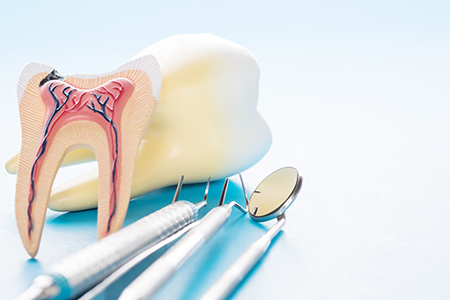Call Today
(908) 852-3693

If a dental professional recommends a root canal, there’s no reason to panic. Modern root canal therapy is a predictable, comfortable treatment designed to relieve deep tooth pain and preserve your natural tooth when the inner tissues have been compromised. In many cases, choosing to treat the tooth is the best way to protect your bite, chewing function, and long-term oral health.
At the office of Dr. Anthony Iuvone, DMD, we combine careful diagnosis with contemporary techniques to make the process as efficient and painless as possible. Our focus is on clear communication, gentle care, and restoring teeth so patients can return to eating and speaking normally without ongoing discomfort.
Saving a tooth is almost always preferable to removing it. A tooth that has been treated with root canal therapy can function for many years — often a lifetime — when properly restored. Retaining the natural tooth helps maintain adjacent teeth, preserves bone levels, and avoids the functional compromises that can come with replacing a missing tooth.
Today’s root canal techniques are far more refined than in the past. With improved imaging, nickel-titanium instruments, and better filling materials, clinicians can clean and seal complex canal anatomy more predictably. These advances translate into shorter appointments, less discomfort, and higher long-term success rates for patients.
Deciding whether to treat a tooth involves a careful assessment of the remaining tooth structure, bone support, and overall dental health. When adequate tooth material and support are present, root canal therapy lets you keep the tooth in place and preserve natural function rather than turning immediately to extraction and replacement options.

Inside each tooth lies a small chamber of soft tissue called the dental pulp. When bacteria reach this area — from deep decay, cracks, or trauma — inflammation and infection can follow. The nerve endings in the pulp often signal trouble long before visible changes appear on the tooth surface, so listening to symptoms matters.
Not all damaged teeth announce themselves loudly. Some give intermittent warnings; others remain quiet until the problem is advanced. Regular exams and radiographs can reveal hidden issues, but patient-reported sensations — especially persistent or severe pain — remain one of the most important clues that prompt timely intervention.
Root canal therapy is recommended when the pulp cannot recover on its own and is causing irreversible inflammation or infection. The goal is to remove the diseased tissue, disinfect the internal spaces, and seal the canals to prevent reinfection so the tooth can continue functioning without pain.
Common signs that may indicate the need for root canal treatment include:
Ongoing tooth pain — especially discomfort that wakes you at night or persists despite common pain relievers — often points to internal tooth inflammation or infection. Early evaluation reduces the chance of complications and preserves treatment options.
An intense, lingering reaction to temperature changes can mean the pulp is inflamed. Sensitivity that doesn’t quickly subside after the stimulus is removed should be checked by a dental professional.
Pain on pressure may indicate that the tooth’s internal tissues or its surrounding bone are involved. This symptom is commonly associated with deeper damage than a simple surface cavity.
A tooth that becomes darker over time can be showing signs of internal change, often from past trauma or long-standing pulp damage. Discoloration alone isn’t definitive, but it’s a useful diagnostic clue when considered with other findings.
Structural damage can expose internal tissues to bacteria or directly injure the pulp. When enough of the tooth is affected, endodontic treatment can stabilize and save the tooth.
Localized swelling, a pimple-like bump on the gum, or persistent gum tenderness can indicate an abscess or draining infection. These signs require prompt evaluation and treatment.
Infection that affects the supporting bone can lead to looseness. Treating the infection and stabilizing the tooth structure often restores health and reduces mobility.

Timely attention to a compromised tooth preserves options. When infection is limited to the tooth, root canal therapy tends to be more straightforward and predictable. Delay allows bacteria to spread and can weaken the tooth or surrounding bone, sometimes narrowing the possibility of a conservative rescue.
Some teeth with significant internal damage show few external symptoms. That’s why routine dental examinations and X-rays play a vital role in catching problems early. Detecting root-end changes or early bone involvement before symptoms escalate often simplifies treatment and shortens recovery.
If a root canal is recommended, scheduling care in a reasonable timeframe helps control symptoms, protect nearby teeth, and reduce the chances of more invasive procedures later. Our team emphasizes thorough diagnosis and swift, thoughtful treatment planning to support the best possible outcomes.
A root canal procedure aims to remove the infected or injured pulp, clean and shape the canals, and seal the internal spaces to prevent reinfection. Most patients receive local anesthesia so the tooth and surrounding tissues are numb, and many procedures are completed comfortably in a single appointment.
Complex cases or teeth with multiple canals may require two visits to ensure complete disinfection and optimal sealing. During treatment, the canals are accessed through a small opening, carefully cleaned with specialized instruments, and irrigated with antimicrobial solutions. Once prepared, the canals are filled with a biocompatible material to provide a long-lasting seal.
For patients who feel anxious about dental treatment, additional sedation options are available to enhance comfort. After the root canal itself, the tooth typically requires a permanent restoration — often a crown — to restore strength and protect the remaining tooth structure from fracture.

Recovery from a root canal is usually quick. Mild tenderness or sensitivity in the treated area is common during the first few days and responds well to over-the-counter pain relievers as recommended by your clinician. These symptoms typically diminish as the surrounding tissues heal.
After treatment, it’s important to protect the tooth until a permanent restoration is placed. A temporary filling or crown may be used initially; for long-term success, a well-fitting permanent crown or an appropriate restoration should be completed in a timely manner to reduce the risk of fracture.
Keeping the area clean with routine brushing and flossing and attending follow-up visits will help ensure healing and detect any concerns early. With correct treatment and regular dental care, a root canal–treated tooth can remain comfortable and functional for many years.
Anesthesia used during the procedure can leave lips and tongue numb for a short time. Avoid chewing or hot beverages until normal sensation returns to prevent accidental injury.
Some soreness after treatment is normal. Over-the-counter analgesics typically control discomfort; your dentist will advise on appropriate medications if stronger relief is needed.
If an active infection is present or there are other risk factors, an antibiotic may be prescribed. It’s important to follow the prescription instructions and complete the course if one is given.
The restored tooth should be treated gently until the permanent restoration is in place. Avoid hard or sticky foods on that side until your dentist confirms the final restoration is complete.
Daily brushing and flossing remain essential after root canal therapy. Good home care supports healing and preserves the life of the restored tooth.
Completing the permanent crown or restoration promptly helps prevent future problems and restores full function so you can bite and chew with confidence.
With careful treatment planning and follow-up, root canal therapy offers a reliable way to stop pain, eliminate infection, and save a tooth that might otherwise be lost. At the office of Dr. Anthony Iuvone, DMD, we are committed to guiding patients through diagnosis, treatment, and restoration with attention to comfort and long-term oral health.
If you’d like to learn more about root canal therapy or discuss whether it’s the right option for you, please contact us for additional information.
A root canal procedure is the best way to save a tooth that has been damaged by decay or injury and preserve your natural smile. The alternative is an extraction and treatment to replace the tooth. While at times a tooth is non-restorable and an extraction is the only option, when possible, it’s best to try and save your natural tooth. With proper care, a tooth with root canal therapy can serve your smile well for many years to come.
Despite lingering myths from before the age of modern dental anesthesia and technology, having a root canal procedure today is as routine and comfortable as visiting the dentist for a filling. While the procedure is performed under local anesthesia with your tooth completely numbed, we can also discuss options in dental sedation.
Whether the symptoms of a dental infection subside after a course of antibiotics, a draining abscess provides you with some temporary pain relief, or a tooth with radiographic evidence of pathology has not yet developed symptoms, it’s essential, before an infection worsens or occurs, to have a root canal procedure performed. In this way, the tooth can be disinfected, filled, and sealed to protect your health and avoid further problems.
If you have sustained a dental injury, have a toothache, jaw pain, swelling, or are experiencing any other unusual and uncomfortable oral symptoms, contact our office immediately for care. Dental problems that have not been evaluated and treated can significantly worsen, producing more severe damage and consequences for the involved teeth, your oral health, and even your overall wellbeing. Once you get in touch with our office, our friendly and compassionate office team will get you in for care at your earliest convenience.
While some root canal procedures can be completed in one visit, others may involve 2 or 3 appointments. How long it takes depends on various factors, including active infection, the number of canals in the tooth, and the tooth’s location or anatomy.
With a success rate that exceeds 95%, root canal therapy remains the most effective procedure to save a tooth in which the inner vital tissues have been damaged. However, as with all healthcare procedures, there are a small percentage of cases where the teeth become symptomatic a second time. The good news is that many of these teeth can still be saved with root canal retreatment or a minor surgical procedure known as an apicoectomy.
The best ways to maintain a tooth with root canal therapy are to get the proper restoration required to rebuild and protect the tooth, maintain proper oral hygiene, and schedule appointments for routine dental checkups and care.
Saving a tooth with root canal therapy is a wise investment that, in the long run, is typically less costly and invasive than having the tooth extracted and replaced with a fixed bridge or implant. As far as the exact cost of care, it can vary depending on which tooth is being treated. Many dental insurance plans provide coverage for root canal therapy. At the office of Dr. Anthony Iuvone, DMD, we do our best to optimize your dental benefits and minimize your out-of-pocket expenses. Our staff will answer all your questions about the cost of care and discuss all your payment options.
At the office of Dr. Anthony Iuvone, DMD, we use the latest technology and most effective methods of care to provide precise and gentle care. Our reputation for excellence is based upon a consistent record of achieving successful treatment outcomes while providing prompt, stress-free, and convenient treatment for every type of dental need.
A root canal is a dental procedure that removes diseased or injured pulp from inside a tooth, disinfects the canal system, and seals the space to prevent reinfection. The goal is to relieve pain and preserve the natural tooth so it can continue to function in the mouth. Modern root canal therapy is predictable and often allows patients to avoid extraction when the tooth structure and support are adequate.
During the procedure a dentist or endodontist carefully accesses the canal system, cleans and shapes the internal spaces, and fills them with a biocompatible material to provide a long-term seal. Most treatments are performed using local anesthesia so the tooth and surrounding tissues are numb and the patient feels minimal discomfort. A permanent restoration, frequently a crown, is placed after root canal therapy to protect the treated tooth from fracture and restore chewing function.
Tooth pain from deep decay, fractures, or trauma often arises when the dental pulp becomes inflamed or infected and the nerve endings inside the tooth signal distress. Root canal therapy removes the damaged pulp and any bacteria present, eliminating the source of inflammation and reducing associated pain. By disinfecting and sealing the canals, the procedure stops ongoing symptoms and prevents the infection from spreading to surrounding bone and tissues.
Following treatment most patients experience rapid improvement in pain and sensitivity as the body heals. Any short-term soreness is usually manageable with over-the-counter analgesics and subsides within a few days. Timely treatment typically reduces the need for more invasive interventions and preserves natural chewing ability.
Common warning signs include persistent or severe tooth pain, heightened sensitivity to hot or cold that lingers after the stimulus is removed, and pain when biting or touching the tooth. Additional indicators are darkening or discoloration of a tooth, a pimple-like bump on the gum near the affected tooth, localized swelling, or unusual looseness that suggests supporting bone may be involved. Some teeth with severe internal damage produce few symptoms, which is why regular dental exams and radiographs are important for early detection.
If you notice these symptoms, prompt evaluation by a dental professional is important because early diagnosis often simplifies treatment and improves outcomes. Your dentist will combine a clinical examination with X-rays and other diagnostic tools to determine whether the pulp is irreversibly inflamed or infected. When root canal therapy is recommended, timely care helps protect adjacent teeth and reduces the risk of more extensive procedures later.
A typical root canal begins with local anesthesia to numb the tooth and surrounding tissues, followed by placement of a rubber dam to isolate the area and keep it dry. The dentist creates a small opening in the crown of the tooth to access the pulp chamber, then uses specialized instruments to remove diseased tissue, clean the canals, and shape them for filling. Antimicrobial irrigants are used throughout to disinfect internal spaces and reduce bacteria to the greatest extent possible.
Once the canals are prepared they are filled with a biocompatible material to seal the system and prevent reinfection, and the access opening is temporarily or permanently restored. Complex cases or teeth with multiple canals may require an additional visit to ensure thorough disinfection. After the root canal the tooth typically needs a crown or equivalent restoration to restore strength and long-term function.
Most patients report that modern root canal treatment is no more uncomfortable than having a routine filling because local anesthesia effectively numbs the area during the procedure. Advances in technique, instrumentation, and pain management have reduced treatment-related discomfort significantly compared with historical perceptions. Any postoperative soreness is usually mild, short-lived, and controlled with over-the-counter pain relievers unless a clinician prescribes otherwise for specific situations.
For patients who experience dental anxiety, additional sedation options are available to improve comfort and decrease stress during the appointment. Your dental team will discuss anesthesia and sedation choices with you so the experience is as calm and pain-free as possible. Prompt treatment of symptoms also reduces the intensity and duration of pain compared with delaying care.
Yes, root canal therapy is often the preferred conservative option to preserve a natural tooth when the pulp is irreversibly damaged by decay, trauma, or infection. Saving the tooth helps maintain the surrounding teeth, supports normal jawbone health, and preserves natural biting and chewing function. In many cases a root canal followed by an appropriate restoration allows the tooth to remain functional for many years, often for the patient's lifetime.
The decision to perform a root canal depends on factors such as the amount of remaining tooth structure, the condition of the supporting bone, and the overall restorative plan. When a tooth is sufficiently restorable and the patient prefers to keep it, endodontic treatment combined with a well-planned restoration is typically the recommended path. Your dentist will explain the options and prognosis so you can make an informed choice that aligns with your oral health goals.
Recovery after root canal therapy is usually straightforward and most patients return to normal activity the same day, with only mild tenderness in the treated area for a few days. It is normal to experience some sensitivity to pressure or mild soreness as surrounding tissues heal, and these symptoms typically respond to over-the-counter analgesics and brief rest. Avoiding hard or sticky foods on the treated side until a permanent restoration is placed helps protect the tooth during the initial healing period.
Keep the area clean with regular brushing and flossing, and attend any scheduled follow-up visits so the dentist can confirm healing and place the final restoration in a timely manner. If swelling, fever, severe pain, or signs of persistent drainage occur after treatment, contact your dental team promptly for evaluation. Proper post-treatment care and timely restoration are important steps in ensuring the long-term success of the treated tooth.
Alternatives to root canal therapy include extraction followed by tooth replacement options such as a dental implant, bridge, or removable prosthesis, as well as monitoring the tooth when the pulp shows the potential to heal on its own. Each alternative has different implications for preserving adjacent teeth, jawbone health, and long-term function, and the best option depends on the individual tooth and the patient's preferences. In some cases, nonsurgical endodontic retreatment, endodontic surgery, or intentional replantation may be considered for previously treated teeth with persistent issues.
Choosing an alternative should involve a careful discussion of risks, benefits, and expected outcomes with your dental provider. When the tooth is restorable and the goal is to preserve natural structure and function, root canal therapy is frequently the most conservative clinical choice. Your dentist can review diagnostic findings and help you weigh alternatives in the context of your overall oral health plan.
With proper care and a well-fitting permanent restoration, a tooth that has undergone root canal therapy can remain healthy and functional for many years, often for the patient’s lifetime. Long-term success depends on factors such as the quality of the root canal filling, the integrity of the final restoration, the amount of remaining tooth structure, and the patient’s oral hygiene and regular dental maintenance. Regular dental visits and prompt attention to new symptoms support ongoing health and early identification of potential problems.
In rare cases teeth that have had root canal treatment may require retreatment or surgical intervention if reinfection or structural failure occurs. Advances in imaging, instruments, and materials have improved predictability and longevity for treated teeth, and many patients enjoy durable results when recommended follow-up care is completed. Discussing your individual prognosis with your dentist will give you the best sense of expected outcomes for your treated tooth.
The office of Dr. Anthony Iuvone, DMD emphasizes careful diagnosis, modern endodontic techniques, and patient comfort when recommending and performing root canal therapy. Our approach combines clear communication, up-to-date instrumentation, and individualized treatment planning to help patients preserve natural teeth and return to normal function with confidence. We prioritize a calm, efficient experience and provide options for anesthesia or additional sedation for anxious patients when appropriate.
Before recommending root canal therapy we perform a thorough assessment that includes clinical examination and radiographic imaging to determine the best course of care. When treatment is indicated we coordinate restorative planning so the treated tooth receives a durable final restoration to protect long-term function. If you have questions about root canal treatment or would like to discuss your specific situation, our team is available to provide information and guidance tailored to your needs.
